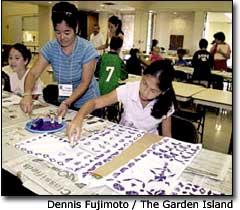LIHU’E — The means by which a culture is perpetuated does not always necessarily have to be boring. Just ask the 39 participants of Warabi Ashibi, the Okinawan Cultural Children’s Camp, who were engrossed in a slew of culturally-appropriate and
LIHU’E — The means by which a culture is perpetuated does not always necessarily have to be boring.
Just ask the 39 participants of Warabi Ashibi, the Okinawan Cultural Children’s Camp, who were engrossed in a slew of culturally-appropriate and rewarding activities yesterday.
In its third year, the three-day camp, which runs through Wednesday at the Kaua’i War Memorial Convention Hall, provides an outlet for students ages 8 to 13 to learn about the Okinawan culture through the creation of crafts, participation in songs and dances, and the building of new friendships.
Sponsored by leaders with Hui Alu, Hawaii United Okinawa Association, the Hawai’i State Foundation of Culture and the Arts, Mayor Bryan J. Baptiste and the County of Kaua’i, and by a grant from Young Brothers Inc., the program is packed with a full schedule of events, which include noodle-making, block-printing, and bon-dancing.
“We even have two special senseis (teachers) from O’ahu,” said cultural camp director Katie Miyashiro. “Today we have June Arakawa, who is teaching the kids how to do the calligraphy and sumie painting. Tomorrow, Warren Andrade will demonstrate the art of raku, or ceramics.
“He’ll bring premade pots, since we are limited by time constraints, have the students glaze their pots, and then fire them up in the kiln.”
Miyashiro, a retired teacher, is assuming the role of director for the first time. “So far, it’s been wonderful; hectic, but wonderful nonetheless. It’s a very big challenge. I’ve been going to bed at like two or three in the morning for the past couple of days, putting things together and making sure that everything is planned just right.”
Miyashiro said the planning phase for the Kaua’i camp this year took place in mid-April. Although the camp got off to a late start, the hard work of the members, volunteers, and sponsors helped get the program flourishing, and increasing in size.
The program began on O’ahu under Hui Alu member Karen Kuba-Hori in 1995, and continued awhile there before being brought to the Neighbor islands.
Before breaking into their designated groups of four for the day, the students were briefed about the purpose of the program, and were taught four Okinawan phrases of greeting.
“The whole point of the camp is mainly to teach the children about the Okinawan culture, especially the language, through various activities and means,” Miyashiro said.
“Each of our four groups of children (headed by a leader, two to three assistant leaders, and one junior leader), bears the name of an animal, either ushi (cow), uma (horse), maya (cat), or tui (chicken). We also incorporate the Okinawan language in a memory-card game, book-making activity, and even our name tags,” she added.
All of the children’s efforts and products will be on display on the final day of the camp, as part of the show-and-tell portion of the program. Parents and the families of the students will be in attendance as they present a special bon dance, wearing their homemade happi coats and beating on their handcrafted drums, to be followed by a buffetstyle lunch.
The camp runs through today, Wednesday, June 22, from 9 a.m. to 2:30 p.m. at the Kaua’i War Memorial Convention Hall in Lihu’e. For more information, please call Katie Miyashiro at 322-9929.


